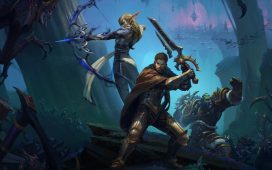A Plague Tale: Innocence opens on a scene of idyllic playfulness: a teenage girl, Amicia, walking her dog through an autumnal forest in 12th-century France, bumping apples from tall trees using pebbles hurled from a homemade slingshot. If this is the “innocence” of the game’s title, it plays but a fleeting cameo role in the drama. Before the day is out, Amicia’s dog is dead – ripped apart by a thrashing mass of rabid vermin – along with her former life of privilege as a French noble, ripped apart by soldiers of the inquisition, thugs acting on behalf of an equally corrupt church.
Amicia and her younger brother Hugo, a boy who suffers from a blood disease and has spent his days in jaundiced confinement, escape the family estate and begin to pick their way through a countryside turned hostile. This is, then, a story of innocence versus experience, of children versus the ruined world of adults, with all its plagues, both physical and ideological.
Every duo has its teacher and its student, its noble and its serf, and in this partnership Amicia is the voice of wisdom and responsibility. Hugo, as a coddled attic child, is bereft of experience, and so in the realm of adventure enjoys low status. The child trips and wanders, oblivious to the scale of the danger the pair face as they creep from bush to bush while attempting to circumnavigate danger.
His naivety infuriates Amicia, who scolds her brother for every misstep. But this is also the glue that binds the relationship: Hugo’s unworldliness agitates in Amicia a duty of care, and this in turn stirs an affection in the young boy for his sisterly guardian. In each chapter there is a flower that, when found, Hugo will pick and fasten in Amicia’s hair, an act of tender love that punctuates this world of excrement and disease.
The embodiment of that disease takes a while to show itself. To begin with, the soldiers pose the primary risk to the children, who must cringe behind carts and in reeds, occasionally hurling a stone into a pile of armour in order to distract the guards for a few seconds and enable safe passage. Materials can be scavenged and, when you reach a workbench, you can upgrade your equipment to enable Amicia to carry more ammunition, for example, or to tread more quietly.
This kind of plodding design is wearied and overfamiliar, but made somehow palatable by the game’s beguiling atmospherics (the sunsets! the haybales!), the convincing voice acting and a medieval context that precludes the use of gadgets that usually fussy up this kind of stealth play.
Then the plague arrives, in all its Old Testament spectacle. Geysers of rats erupt from the earth, a broiling mass of vermin that consume flesh in seconds. The game’s designers spin puzzles from the horde’s sole weakness, a petrifying fear of light. This enables the pair to pick their way forward, just so long as they have a torch or some other light source to hand. It’s a simple solution to a brutish problem, and yet the game’s French developer, Asobo, fashions memorable moments with these basic tools. In one of the game’s most striking scenes you must navigate a field by setting light to a windmill’s two remaining sails, making your dash past 10,000 snipping jaws in time with the blazing sweeps of light.
Much of what makes A Plague Tale: Innocence a success is the admirable way in which the developer spins magic from the routine. The game’s substance borders on cliched, and rarely do its environmental puzzles enjoy more than one solution. Your time, then, is spent tracing the guidelines laid by the designers, without much in the way of meaningful agency. Still, submit yourself to the spell that’s being cast and A Plague Tale: Innocence succeeds in sketching an affecting story of the child’s indefatigable spirit in the face of rats and men.
Also recommended
Observation
(No Code; Devolver Digital; PC, PS4)
Observation’s pitch – Stanley Kubrick’s 2001 from the perspective of the film’s politely malevolent artificial intelligence, Hal – is beguiling and straightforward. It’s a vision to which the game’s Scottish developer, No Code, mostly cleaves. You assume the role of SAM, a sentient AI tasked with running a space station, who, at the game’s opening, must help the crew’s doctor after an accident that neither of you can remember.
Playing as the computer on which a human makes incessant, impatient demands is an undeniable novelty, and the texture of the interactions soon shifts from routine busywork (identifying areas of structural damage, opening airlocked hatches) to more disquieting activities.
Style elevates the substance: the game’s CRT aesthetic, all bursts of static and screen-shake, calls to mind the triumphant Alien: Isolation, a game on which members of this team also worked, while the synth-rasping soundtrack adds an incessant note of tension. Yet for all its sci-fi influences, Observation draws a unique identity from the familiar.














